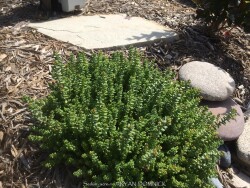

***Description for this perennial available with future update!***Mossy Stonecrop / Sedum, is also known as Sedum acre
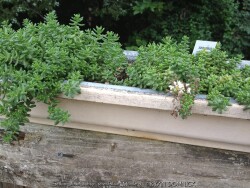

***Description for this perennial available with future update!***White Creeping Sedum, is also known as Sedum album


***Description for this perennial available with future update!***Blue Corsican Sedum, is also known as Sedum dasyphyllum 'Major'
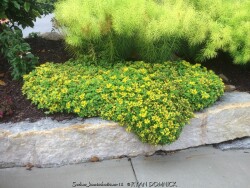

Kamtschaticum Sedum (Sedum kamtschaticum) is known for its compact mats of bright green foliage and yellow-gold flowers in the spring. Fall color turns a beautiful firey orange-red before going dormant. Kamtschaticum Sedum is native to northern China and along the Pacific coast of Siberia including the Kamchatka Peninsula with a similar climate of cold winters and hot summers. Bright green growth emerges early in the spring and spread slowly, rooting a little bit as it spreads but not aggressively. Growth is dense enough to resist most weeds. Kamtschaticum Sedum is useful as a small scale groundcover, rock garden plant, retaining wall plant, or even dry shade gardens. This tough sedum will grow in full sun to full shade in just about any soil except for wet poorly drained ones. Of all of the sedums, this is probably the most resistant to any kind of problems including root rot. I have witnessed clumps surviving and thriving for 20-30 years or more. There is really almost no maintenance with this sedum but you may choose to weed eat it in the winter for a more tidy appearance. The only slight problem is that when grown with too much water, The crown opens up as it flops over and looks slightly untidy. The flowering period is also pretty short. Considered one of the best plants for solving your most difficult dry-shade landscape challenges.
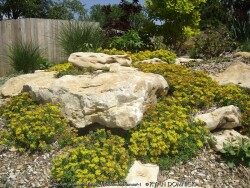

Kamtschaticum Sedum (Sedum kamtschaticum) is known for its compact mats of bright green foliage and yellow-gold flowers in the spring. Fall color turns a beautiful firey orange-red before going dormant. Kamtschaticum Sedum is native to northern China and along the Pacific coast of Siberia including the Kamchatka Peninsula with a similar climate of cold winters and hot summers. Bright green growth emerges early in the spring and spread slowly, rooting a little bit as it spreads but not aggressively. Growth is dense enough to resist most weeds. Kamtschaticum Sedum is useful as a small scale groundcover, rock garden plant, retaining wall plant, or even dry shade gardens. This tough sedum will grow in full sun to full shade in just about any soil except for wet poorly drained ones. Of all of the sedums, this is probably the most resistant to any kind of problems including root rot. I have witnessed clumps surviving and thriving for 20-30 years or more. There is really almost no maintenance with this sedum but you may choose to weed eat it in the winter for a more tidy appearance. The only slight problem is that when grown with too much water, The crown opens up as it flops over and looks slightly untidy. The flowering period is also pretty short. Considered one of the best plants for solving your most difficult dry-shade landscape challenges. Tooth-Leaf Kamtschaticum Sedum (Sedum kamtschaticum var. middendorffianum) is a shorter more drought tolerant variety with tooth-like jagged edges. The clump does not open up and flop. This variety is also more tolerant of full hot sun and shallow soils also making it an ideal roof-garden plant.
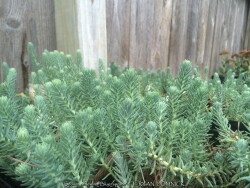

***Description for this perennial available with future update!***Blue Spruce Sedum, is also known as Sedum reflexum
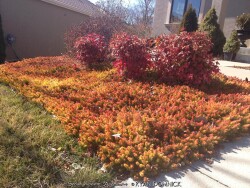

***Description for this perennial available with future update!***Angelina Gold & Orange Sedum, is also known as Sedum rupestre 'Angelina'
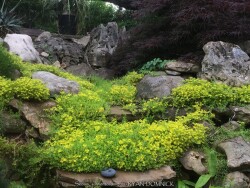

***Description for this perennial available with future update!*** Sedum sarmentosum is also known as Gold Moss Dry Shade Sedum>>>>> This plant can also be in a water garden stream as long as the water is constantly moving: stagnant water is not tolerated. Considered one of the best plants for solving your most difficult dry-shade landscape challenges.
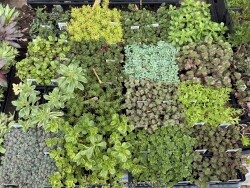

***Description for this perennial available with future update!***Sedum (Mixed Groundcover flats), is also known as Sedum sp.


***Description for this perennial available with future update!***Sedum (Mixed Varieties) (large), is also known as Sedum sp.
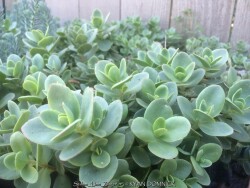

***Description for this perennial available with future update!***Sedum (Mixed Varieties) (small), is also known as Sedum sp.
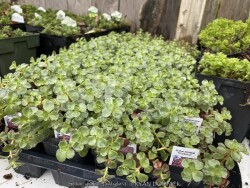

***Description for this perennial available with future update!***Improved Dragon's Blood Sedum, is also known as Sedum spurium 'Fuldaglut' / 'Fulda Glow'


Kamtschaticum Sedum (Sedum kamtschaticum) is known for its compact mats of bright green foliage and yellow-gold flowers in the spring. Fall color turns a beautiful firey orange-red before going dormant. Kamtschaticum Sedum is native to northern China and along the Pacific coast of Siberia including the Kamchatka Peninsula with a similar climate of cold winters and hot summers. Bright green growth emerges early in the spring and spread slowly, rooting a little bit as it spreads but not aggressively. Growth is dense enough to resist most weeds. Kamtschaticum Sedum is useful as a small scale groundcover, rock garden plant, retaining wall plant, or even dry shade gardens. This tough sedum will grow in full sun to full shade in just about any soil except for wet poorly drained ones. Of all of the sedums, this is probably the most resistant to any kind of problems including root rot. I have witnessed clumps surviving and thriving for 20-30 years or more. There is really almost no maintenance with this sedum but you may choose to weed eat it in the winter for a more tidy appearance. The only slight problem is that when grown with too much water, The crown opens up as it flops over and looks slightly untidy. The flowering period is also pretty short. Considered one of the best plants for solving your most difficult dry-shade landscape challenges. Big-Leaf Kamtschaticum Sedum (Sedum takesimensis / kamtschaticum) is taller with larger leaves and larger flowers, about double that of the species.
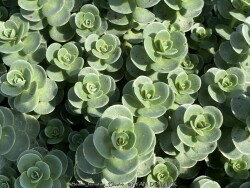

***Description for this perennial available with future update!***Native White Sedum, is also known as Sedum ternatum
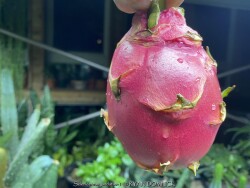

Dragon Fruit cacti are grown for delicious nutritious fruits. This tropical jungle cactus has a few requirements in order to thrive but nothing too hard. Give them bright indirect light and water only when dry. They are usually grown as a house plant in Kansas but can be moved outside if kept in part shade to shade. Leaves can sunburn but morning or filtered sun is ok! Dragon Fruit, like all true cacti, originates in the Americas. It is a sprawling or vining, terrestrial or epiphytic cactus. They climb trees and walls by use of aerial roots and can reach a height of 30 feet in the wild. Protect from temperatures below 45 degrees F and move into a bright window over the winter with no watering. As a winter house plant, it will look presentable all winter long with just a few waterings. Repotting may or may not be needed depending on how large you want the plant to grow; plants can continue to grow in the same pot for years. If repotting, make sure to use a sharp draining highly organic cactus mix with plenty of sand and perlite. This is relatively uncommon plant never seen at the big box stores and will command a higher price than most other houseplants. Plants are usually grown in hanging baskets and take up alot of space. Fruit may or may not occur in this climate; I have seen flowering but not fruit.
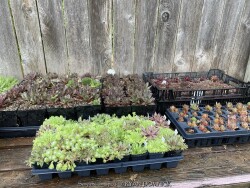

These tiny perennial succulents (Sempervivum sp.) produce various colored mats of foliage rosettes. In favorable conditions they can spread rapidly by offsets; several species are valued in cultivation as groundcover for dry, sunny locations. Hen & Chicks are native to alpine mountainous areas in native to southern Europe and northern Africa. Grow this small native gem in a rock garden, in cracks between rocks, or on top of or in a retaining wall. You may also grow in flat areas like in between stepping stones provided you used a gravelly or sandy base for the stones. It will not tolerate rich moist soils as other plants or weeds will shade it out. Crown rot can occur during lengthy hot humid summer rainy periods. Hen & Chicks do not thrive indoors; aphids and spider mites seem to find them after a few months but overwintering indoors in a cool environment may work. Plants with plenty of time to acclimate will thrive in full sun but be careful not to rush it or sunburning will occur. Generally if moving outside for the summer, allow 2-3 weeks of part shade or morning sun before placing in full sun. If grown in pots and kept on the dry side, you may leave out all winter allowing to freeze solid; plants will go dormant and resume growth in the spring. This is more successful than overwintering inside. Great low maintenance cold hardy succulent.
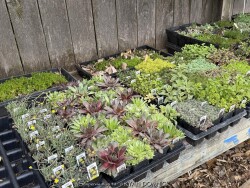

These tiny perennial succulents (Sempervivum sp.) produce various colored mats of foliage rosettes. In favorable conditions they can spread rapidly by offsets; several species are valued in cultivation as groundcover for dry, sunny locations. Hen & Chicks are native to alpine mountainous areas in native to southern Europe and northern Africa. Grow this small native gem in a rock garden, in cracks between rocks, or on top of or in a retaining wall. You may also grow in flat areas like in between stepping stones provided you used a gravelly or sandy base for the stones. It will not tolerate rich moist soils as other plants or weeds will shade it out. Crown rot can occur during lengthy hot humid summer rainy periods. Hen & Chicks do not thrive indoors; aphids and spider mites seem to find them after a few months but overwintering indoors in a cool environment may work. Plants with plenty of time to acclimate will thrive in full sun but be careful not to rush it or sunburning will occur. Generally if moving outside for the summer, allow 2-3 weeks of part shade or morning sun before placing in full sun. If grown in pots and kept on the dry side, you may leave out all winter allowing to freeze solid; plants will go dormant and resume growth in the spring. This is more successful than overwintering inside. Great low maintenance cold hardy succulent.
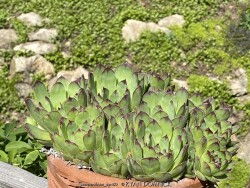

These tiny perennial succulents (Sempervivum sp.) produce various colored mats of foliage rosettes. In favorable conditions they can spread rapidly by offsets; several species are valued in cultivation as groundcover for dry, sunny locations. Hen & Chicks are native to alpine mountainous areas in native to southern Europe and northern Africa. Grow this small native gem in a rock garden, in cracks between rocks, or on top of or in a retaining wall. You may also grow in flat areas like in between stepping stones provided you used a gravelly or sandy base for the stones. It will not tolerate rich moist soils as other plants or weeds will shade it out. Crown rot can occur during lengthy hot humid summer rainy periods. Hen & Chicks do not thrive indoors; aphids and spider mites seem to find them after a few months but overwintering indoors in a cool environment may work. Plants with plenty of time to acclimate will thrive in full sun but be careful not to rush it or sunburning will occur. Generally if moving outside for the summer, allow 2-3 weeks of part shade or morning sun before placing in full sun. If grown in pots and kept on the dry side, you may leave out all winter allowing to freeze solid; plants will go dormant and resume growth in the spring. This is more successful than overwintering inside. Great low maintenance cold hardy succulent. Red-tip Green Hen & Chicks are among the largest, most reliable, and fastest growing.
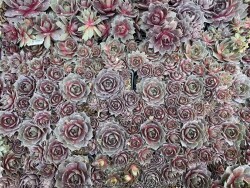

These tiny perennial succulents (Sempervivum sp.) produce various colored mats of foliage rosettes. In favorable conditions they can spread rapidly by offsets; several species are valued in cultivation as groundcover for dry, sunny locations. Hen & Chicks are native to alpine mountainous areas in native to southern Europe and northern Africa. Grow this small native gem in a rock garden, in cracks between rocks, or on top of or in a retaining wall. You may also grow in flat areas like in between stepping stones provided you used a gravelly or sandy base for the stones. It will not tolerate rich moist soils as other plants or weeds will shade it out. Crown rot can occur during lengthy hot humid summer rainy periods. Hen & Chicks do not thrive indoors; aphids and spider mites seem to find them after a few months but overwintering indoors in a cool environment may work. Plants with plenty of time to acclimate will thrive in full sun but be careful not to rush it or sunburning will occur. Generally if moving outside for the summer, allow 2-3 weeks of part shade or morning sun before placing in full sun. If grown in pots and kept on the dry side, you may leave out all winter allowing to freeze solid; plants will go dormant and resume growth in the spring. This is more successful than overwintering inside. Great low maintenance cold hardy succulent. Burgundy Hen & Chicks (Sempervivum tectorum) are brightly colored with new growth emerging bright purple darkening with age.


String of Bananas (Senecio / Curio radicans) grows long green stems with interesting banana-shaped alternating leaves. They are usually grown as a patio or house plant in Kansas. String of Bananas also grow well in hanging baskets as a durable, succulent plant able to survive drying out, heat and dry air like few others! To play is safe, potted plants are best moved in before night temperatures get below 45 degrees F. It is important to avoid the combination of wet and cold. Before extreme cold occurs, move to a bright interior window over the winter with no watering and keep above freezing. As a winter house plant, it will look presentable all winter long with just no waterings. As a permanent house plant, provide bright light and allow the soil to dry between waterings for many years of carefree enjoyment. Generally if moving outside for the summer, allow 1-2 weeks of part shade or morning sun before placing in full sun. Plants with time to acclimate will thrive in full sun but be careful not to rush it or sunburning will occur. Full hot sun over 100 degrees F can also burn the top of the hanging basket killing the stems where they touch the pot rim and dirt. Avoid this by moving into part-shade during the hottest part of the summer. Potted plants are very low maintenance. I have never seen any insect problems on this plant. String of Bananas is the toughest, most trouble-free of the Senecio cascaders.
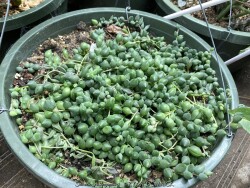

String of Pearls (Senecio / Curio rowleyanus) grows long green stems with interesting sphere-shaped alternating leaves. They are usually grown as a patio or house plant in Kansas. String of Pearls also grow well in hanging baskets as a durable, succulent plant able to survive drying out, heat and dry air like few others! To play is safe, potted plants are best moved in before night temperatures get below 45 degrees F. It is important to avoid the combination of wet and cold. Before extreme cold occurs, move to a bright interior window over the winter with no watering and keep above freezing. As a winter house plant, it will look presentable all winter long with just no waterings. As a permanent house plant, provide bright light and allow the soil to dry between waterings for many years of carefree enjoyment. Generally if moving outside for the summer, allow 1-2 weeks of part shade or morning sun before placing in full sun. Plants with time to acclimate will thrive in full sun but be careful not to rush it or sunburning will occur. Full hot sun over 100 degrees F can also burn the top of the hanging basket killing the stems where they touch the pot rim and dirt. Avoid this by moving into part-shade during the hottest part of the summer. Potted plants are very low maintenance. I have never seen any insect problems on this plant.
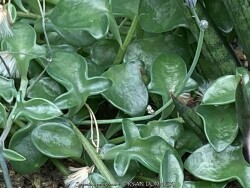

String of Dolphins (Senecio / Curio x peregrinum) grows long green stems with interesting dolphin-shaped alternating leaves. They are usually grown as a patio or house plant in Kansas. String of Dolphins also grow well in hanging baskets as a durable, succulent plant able to survive drying out, heat and dry air like few others! To play is safe, potted plants are best moved in before night temperatures get below 45 degrees F. It is important to avoid the combination of wet and cold. Before extreme cold occurs, move to a bright interior window over the winter with no watering and keep above freezing. As a winter house plant, it will look presentable all winter long with just no waterings. As a permanent house plant, provide bright light and allow the soil to dry between waterings for many years of carefree enjoyment. Generally if moving outside for the summer, allow 1-2 weeks of part shade or morning sun before placing in full sun. Plants with time to acclimate will thrive in full sun but be careful not to rush it or sunburning will occur. Full hot sun over 100 degrees F can also burn the top of the hanging basket killing the stems where they touch the pot rim and dirt. Avoid this by moving into part-shade during the hottest part of the summer. Potted plants are very low maintenance. I have never seen any insect problems on this plant.
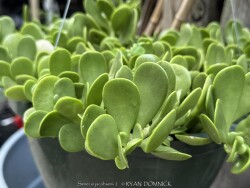

***Description for this plant available with future update!*** Senecio jacobsenii is also known as Trailing Jade Vine (Tropical).
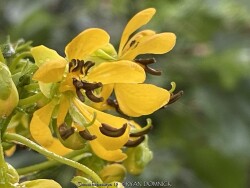

***Description for this perennial available with future update!*** Senna marilandica / hebecarpa is also known as Wild Senna.
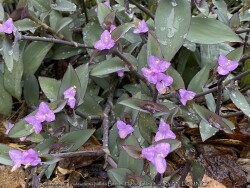

Purple Heart (Setcreasea / Tradescantia pallida 'Purple Heart') is the most versatile plant in out library: it can be an annual, perennial, patio plant, house plant, or hanging basket in wet or dry soil in full shade or full sun. It can handle growing in standing water or bone dry. In dry soils, it shows no drought stress, continuing to grow with a deeper purple shade. In moist soils, this plant will grow rapidly. In shade, the foliage becomes more greenish but still looks attractive. In Kansas, it is usually grown as an annual. Brilliant purple leaves contrast small pink flowers in the summer! Plants will quickly fill an annual bed with bright purple color all summer til first hard freeze. In the ground, it is possible to overwinter these in the ground in Kansas by placing a giant 6-8" mound of mulch over deeply planted rhizomes. Not sure what's easier, buying and moving that much mulch or replanting in spring?: you decide. If growing as a potted plant and trying to overwinter, allowing the foliage to frost is ok, it will not kill the root system. However, do not allow the pot with rootball to freeze solid or go below 20 degrees for more than a few hours. Allow to go dormant as needed with little care, just cut off dead foliage and place back out in April or May with a time-release fertilizer. Many plants will die back slowly and remain attractive inside for most of the winter. Purple heart plants have no insect, disease or animal pests. Botanical name has recently changed from Setcreasea to Tradescantia. This 'Giant' form (Setcreasea / Tradescantia pallida 'Kartuz Giant'), originally purchased at Bustani Plant Farm in Stillwater Oklahoma, has much larger tropical-like foliage. This form survived -16 degrees F and a week of single digit highs in February, 2021 with 3-4" of mulch.


Purple Heart (Setcreasea / Tradescantia pallida 'Purple Heart') is the most versatile plant in out library: it can be an annual, perennial, patio plant, house plant, or hanging basket in wet or dry soil in full shade or full sun. It can handle growing in standing water or bone dry. In dry soils, it shows no drought stress, continuing to grow with a deeper purple shade. In moist soils, this plant will grow rapidly. In shade, the foliage becomes more greenish but still looks attractive. In Kansas, it is usually grown as an annual. Brilliant purple leaves contrast small pink flowers in the summer! Plants will quickly fill an annual bed with bright purple color all summer til first hard freeze. In the ground, it is possible to overwinter these in the ground in Kansas by placing a giant 6-8" mound of mulch over deeply planted rhizomes. Not sure what's easier, buying and moving that much mulch or replanting in spring?: you decide. If growing as a potted plant and trying to overwinter, allowing the foliage to frost is ok, it will not kill the root system. However, do not allow the pot with rootball to freeze solid or go below 20 degrees for more than a few hours. Allow to go dormant as needed with little care, just cut off dead foliage and place back out in April or May with a time-release fertilizer. Many plants will die back slowly and remain attractive inside for most of the winter. Purple heart plants have no insect, disease or animal pests. Botanical name has recently changed from Setcreasea to Tradescantia. This 'Giant' form (Setcreasea / Tradescantia pallida 'Kartuz Giant'), originally purchased at Bustani Plant Farm in Stillwater Oklahoma, has much larger tropical-like foliage. This form survived -16 degrees F and a week of single digit highs in February, 2021 with 3-4" of mulch.
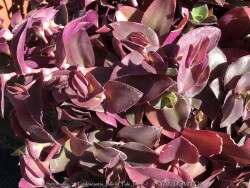

Purple Heart (Setcreasea / Tradescantia pallida 'Purple Heart') is the most versatile plant in out library: it can be an annual, perennial, patio plant, house plant, or hanging basket in wet or dry soil in full shade or full sun. It can handle growing in standing water or bone dry. In dry soils, it shows no drought stress, continuing to grow with a deeper purple shade. In moist soils, this plant will grow rapidly. In shade, the foliage becomes more greenish but still looks attractive. In Kansas, it is usually grown as an annual. Brilliant purple leaves contrast small pink flowers in the summer! Plants will quickly fill an annual bed with bright purple color all summer til first hard freeze. In the ground, it is possible to overwinter these in the ground in Kansas by placing a giant 6-12" mound of mulch over deeply planted rhizomes. Not sure what's easier, buying and moving that much mulch or replanting in spring?: you decide. If growing as a potted plant and trying to overwinter, allowing the foliage to frost is ok, it will not kill the root system. However, do not allow the pot with rootball to freeze solid or go below 20 degrees for more than a few hours. Allow to go dormant as needed with little care, just cut off dead foliage and place back out in April or May with a time-release fertilizer. Many plants will die back slowly and remain attractive inside for most of the winter. Purple heart plants have no insect, disease or animal pests. Botanical name has recently changed from Setcreasea to Tradescantia. The 'Pale Puma' form (Setcreasea / Tradescantia pallida 'Pale Puma') has much more compact foliage and dense root system. When grown in a hanging basket, the foliage creates a purple globe effect. We have not tested this variety for outdoor hardiness in our Lawrence, KS (zone 6a) garden yet (2022).
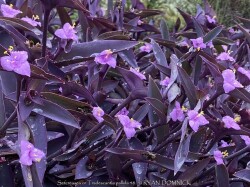

Purple Heart (Setcreasea / Tradescantia pallida 'Purple Heart') is the most versatile plant in out library: it can be an annual, perennial, patio plant, house plant, or hanging basket in wet or dry soil in full shade or full sun. It can handle growing in standing water or bone dry. In dry soils, it shows no drought stress, continuing to grow with a deeper purple shade. In moist soils, this plant will grow rapidly. In shade, the foliage becomes more greenish but still looks attractive. In Kansas, it is usually grown as an annual. Brilliant purple leaves contrast small pink flowers in the summer! Plants will quickly fill an annual bed with bright purple color all summer til first hard freeze. In the ground, it is possible to overwinter these in the ground in Kansas by placing a 6-8" mound of mulch over deeply planted rhizomes. Not sure what's easier, buying and moving that much mulch or replanting in spring?: you decide. If growing as a potted plant and trying to overwinter, allowing the foliage to frost is ok, it will not kill the root system. However, do not allow the pot with rootball to freeze solid or go below 20 degrees for more than a few hours. Allow to go dormant as needed with little care, just cut off dead foliage and place back out in April or May with a time-release fertilizer. Many plants will die back slowly and remain attractive inside for most of the winter. Purple heart plants have no insect, disease or animal pests. Botanical name has recently changed from Setcreasea to Tradescantia. A variegated form is also available. This plant survived in our Lawrence, KS display garden down to -16 degrees F and a week of single digit highs in February, 2021 with mulch.
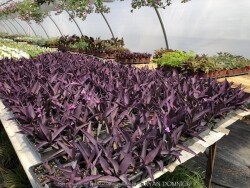

Purple Heart (Setcreasea / Tradescantia pallida 'Purple Heart') is the most versatile plant in out library: it can be an annual, perennial, patio plant, house plant, or hanging basket in wet or dry soil in full shade or full sun. It can handle growing in standing water or bone dry. In dry soils, it shows no drought stress, continuing to grow with a deeper purple shade. In moist soils, this plant will grow rapidly. In shade, the foliage becomes more greenish but still looks attractive. In Kansas, it is usually grown as an annual. Brilliant purple leaves contrast small pink flowers in the summer! Plants will quickly fill an annual bed with bright purple color all summer til first hard freeze. In the ground, it is possible to overwinter these in the ground in Kansas by placing a 6-8" mound of mulch over deeply planted rhizomes. Not sure what's easier, buying and moving that much mulch or replanting in spring?: you decide. If growing as a potted plant and trying to overwinter, allowing the foliage to frost is ok, it will not kill the root system. However, do not allow the pot with rootball to freeze solid or go below 20 degrees for more than a few hours. Allow to go dormant as needed with little care, just cut off dead foliage and place back out in April or May with a time-release fertilizer. Many plants will die back slowly and remain attractive inside for most of the winter. Purple heart plants have no insect, disease or animal pests. Botanical name has recently changed from Setcreasea to Tradescantia. A variegated form is also available. This plant survived in our Lawrence, KS display garden down to -16 degrees F and a week of single digit highs in February, 2021 with mulch.
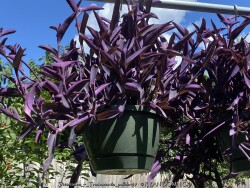

Purple Heart (Setcreasea / Tradescantia pallida 'Purple Heart') is the most versatile plant in out library: it can be an annual, perennial, patio plant, house plant, or hanging basket in wet or dry soil in full shade or full sun. It can handle growing in standing water or bone dry. In dry soils, it shows no drought stress, continuing to grow with a deeper purple shade. In moist soils, this plant will grow rapidly. In shade, the foliage becomes more greenish but still looks attractive. In Kansas, it is usually grown as an annual. Brilliant purple leaves contrast small pink flowers in the summer! Plants will quickly fill an annual bed with bright purple color all summer til first hard freeze. In the ground, it is possible to overwinter these in the ground in Kansas by placing a 6-8" mound of mulch over deeply planted rhizomes. Not sure what's easier, buying and moving that much mulch or replanting in spring?: you decide. If growing as a potted plant and trying to overwinter, allowing the foliage to frost is ok, it will not kill the root system. However, do not allow the pot with rootball to freeze solid or go below 20 degrees for more than a few hours. Allow to go dormant as needed with little care, just cut off dead foliage and place back out in April or May with a time-release fertilizer. Many plants will die back slowly and remain attractive inside for most of the winter. Purple heart plants have no insect, disease or animal pests. Botanical name has recently changed from Setcreasea to Tradescantia. A variegated form is also available. This plant survived in our Lawrence, KS display garden down to -16 degrees F and a week of single digit highs in February, 2021 with mulch.
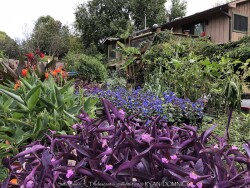

Purple Heart (Setcreasea / Tradescantia pallida 'Purple Heart') is the most versatile plant in out library: it can be an annual, perennial, patio plant, house plant, or hanging basket in wet or dry soil in full shade or full sun. It can handle growing in standing water or bone dry. In dry soils, it shows no drought stress, continuing to grow with a deeper purple shade. In moist soils, this plant will grow rapidly. In shade, the foliage becomes more greenish but still looks attractive. In Kansas, it is usually grown as an annual. Brilliant purple leaves contrast small pink flowers in the summer! Plants will quickly fill an annual bed with bright purple color all summer til first hard freeze. In the ground, it is possible to overwinter these in the ground in Kansas by placing a 6-8" mound of mulch over deeply planted rhizomes. Not sure what's easier, buying and moving that much mulch or replanting in spring?: you decide. If growing as a potted plant and trying to overwinter, allowing the foliage to frost is ok, it will not kill the root system. However, do not allow the pot with rootball to freeze solid or go below 20 degrees for more than a few hours. Allow to go dormant as needed with little care, just cut off dead foliage and place back out in April or May with a time-release fertilizer. Many plants will die back slowly and remain attractive inside for most of the winter. Purple heart plants have no insect, disease or animal pests. Botanical name has recently changed from Setcreasea to Tradescantia. A variegated form is also available. This plant survived in our Lawrence, KS display garden down to -16 degrees F and a week of single digit highs in February, 2021 with mulch.
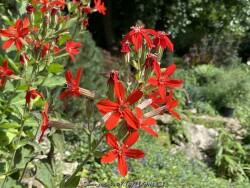

***Description for this perennial available with future update!***Scarlet Royal Catchfly / Silene, is also known as Silene regia
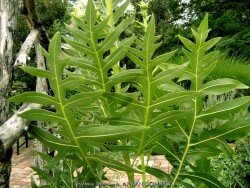

***Description for this perennial available with future update!*** Silphium laciniatum is also known as Compass Plant / Silphium >>>>>>>>>>>>Silphiums (Silphium laciniatum) are very long-lived perennials considered a "Once it's there, it's there forever" plant!
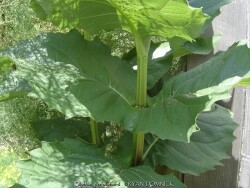

***Description for this perennial available with future update!*** Silphium perfoliatum is also known as Cup Plant / Silphium >>>>>>>>>>>>Silphium perfoliatum (Silphium perfoliatum) >>>>>>>>is also grown as a large bog plant needing constantly moist soil rich in organic matter. As a rain garden plant, it will thrive is a depressed area in the landscape that collects rain water from a roof during spring and summer periods of rain but then >>>>>might go partially dormant if the water hole dries out completely. Considered a "Once it's there, it's there forever" plant!
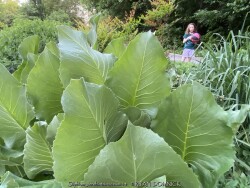

***Description for this perennial available with future update!*** Silphium terebinthinaceum is also known as Prairie Dock / Silphium >>>>>>>>>>>>Considered a "Once it's there, it's there forever" plant!
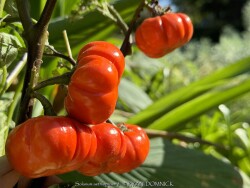

***Description for this plant available with future update!***Solanum aethiopicum is also known as Nakati / Pumpkin-on-a-Stick / Garden Eggs (Tropical)>>>>>> Easy to Eat Edible
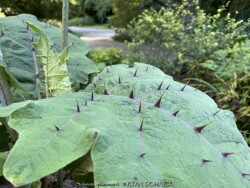

***Description for this plant available with future update!***Naranjilla / Bed of Nails (Tropical), is also known as Solanum quitoense. Easy to Eat Edible.


Bluestem Goldenrod (Solidago caesia) is a perennial wildflower with arching blue-green stems is native to the eastern and central parts of the United States and Canada. This woodland goldenrod occurs in open upland woods, shaded bluffs, slopes of wooded ravines and rocky cliffs. Yellow late-summer flowers contrast nicely with bluish purple stems. Considered one of the best plants for solving your most difficult dry-shade landscape challenges and still providing flowers if given at least a couple hours of sun or all-day dappled sun through the trees. Goldenrods are not wind-pollinated and therefore do not cause standard hay fever or allergies. This goldenrod attracts native bees, wasps and pollinating flies. Rabbit and deer resistance is good. This goldenrod has been planted in our trial gardens over 15 years ago on a dry-shade berm with 2-3 hrs of morning sun. The slowly expanding clump is virtually maintenance free, only needing trimmed in fate fall. This species does not spread by rhizomes or runners like some other goldenrods but will self-seed prolifically if you do not mulch. Bluestem Goldenrod is not well known or available in garden centers but worthy of wider scale landscape use.
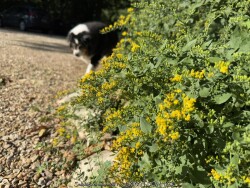

***Description for this perennial available with future update!*** Solidago drummondii is also known as Cliff Goldenrod.
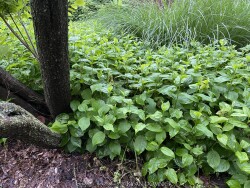

Zig Zag Goldenrod (Solidago flexicaulis) is native to the eastern and central parts of the United States and Canada. This woodland goldenrod, with erect, somewhat zig-zag stems, bears small flower heads at each node along the stem and upper leaves. The oval leaves are a rich green, pointed, and coarsely toothed. Considered one of the best plants for solving your most difficult dry-shade landscape challenges and still providing flowers. Goldenrods are not wind-pollinated and therefore do not cause standard hay fever or allergies. This goldenrod attracts butterflies. Rabbit and deer resistance is good. Zig Zag Goldenrod has been planted in our trial gardens over 10 years ago on a hill in part-sun to dry shade. The slowly expanding clump is virtually maintenance free, only needing trimmed in fate fall. Zig Zag Goldenrod is not well known or available in garden centers but worthy of wider scale landscape use.
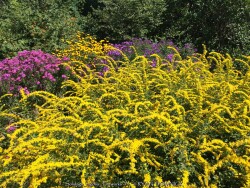

Fireworks Goldenrod (Solidago rugosa 'Fireworks') is the most garden-worthy of the goldenrods! It features dark green upright foliage. As the flower panicle matures, the expanding buds create a fine-textures cloud-like effect for about a month before the flowers open. When the flowers finally open in September, the radiating form really looks like fireworks! After flowering, the dried flower structure holds up well into fall offering winter interest until the first wet heavy snow. The species, Solidago rugosa, is native to the eastern and central parts of the United States and Canada. It is a highly adaptable goldenrod occuring in open moist areas such as low woods, meadows, old fields, pine barrens, and bogs. It is more tolerant of wet soils that other goldenrod. It prefers locations in full sun in average to moist soils that are well-drained but is adaptable to part shade or dappled shade. In Eastern Kansas, typically our 40 inches of rainfall is sufficient without extra water if planted in good soils. During the drought years in Eastern Kansas of 2011 and 2012, many Fireworks Goldenrods planted in landscapes that were not watered survived but dried up as flowers were trying to form. Goldenrods are not wind-pollinated and therefore do not cause standard hay fever or allergies. This goldenrod attracts wide variety of insects, including small bees, wasps, flies, small butterflies. Rabbit and deer resistance is good. The slowly expanding clump is virtually maintenance free, only needing trimmed in fate fall. Fireworks Goldenrod is generally very pest and disease resistant and can spread by creeping rhizomes or seed. Fireworks Goldenrod has been planted in our trial gardens over 18 years in mostly full sun with average garden soil. This is among our favorite perennials with truely 4 seasons of interest!
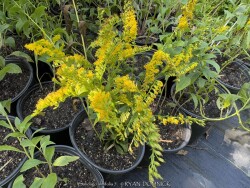

***Description for this perennial available with future update!*** Solidago ulmifolia is also known as Elm Leaf Goldenrod.
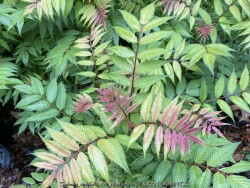

***Shrub descriptions available with future update!*** Sorbaria sorbifolia 'Mr. Mustard' is also known as Mr. Mustard Ural False Spirea >>>>>>>>>>>>Fabulously funky! Mr. Mustard boasts extraordinarily colorful foliage - yellow, orange, red, pink, and lime green meld together in springtime to make a truly memorable show. By summertime, the foliage mellows to a vibrant Kelly green and complements the fabulous creamy white flowers. These large, astilbe-like blooms attract butterflies and pollinators and its suckering habit lends a naturalized look to any garden. With some annual pruning, it easily keeps its mounded habit, suiting it perfectly for mixed beds. >>>>>>All Proven Winners® plants are legally propagated, healthy and vigorous, true to name, and tagged with color pictures and growing information. >>>>>>>>Ultra cold-hardy plants from northern climates normally dislike our long hot humid summers; although we are on the Southern edge of this plants adaptability, it still survives reasonably well here. Look for a cold microclimate planting location such as East or North exposure.>>>>>
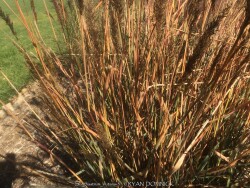

Indian Grass (Sorghastrum nutans) is easily grown in average, dry to medium, well-drained soils in full sun. It is tolerant of a wide range of soils and growing conditions but tends to flop in rich moist soils. This ornamantal grass is a tall, Kansas native, perennial, warm season grass that dominates much of the tall grass prairie extending into the Flint Hills. In fact, Indiangrass, Big bluestem, Little bluestem, and Switchgrass comprise 75% of the species in this ecosystem. It may be grown as an ornamental grass because of its attractive foliage which changes color seasonally along with its good architectural height and its interesting yellow flower/seed heads. Indian Steel Indian Grass (Sorghastrum nutans 'Indian Steel') has improved bluish green foliage that turns yellow in fall and retain some gold color throughout the winter. Feathery panicles of tan-yellow flowers appear well above the foliage in late summer to early fall adding winter interest
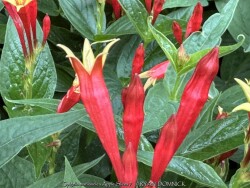

***Description for this perennial available with future update!***Spigelia / Indian Pink, is also known as Spigelia marilandica
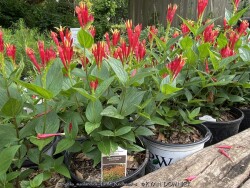

***Description for this perennial available with future update!***Little Red Head Spigelia / Indian Pink, is also known as Spigelia marilandica 'Little Red Head'
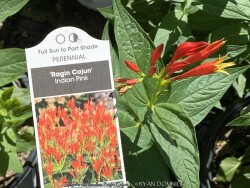

***Description for this perennial available with future update!***Ragin Cajun' Spigelia / Indian Pink, is also known as Spigelia marilandica 'Ragin Cajun'
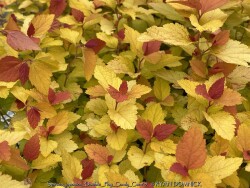

***Shrub descriptions available with future update!***Double Play Candy Corn Spirea, is also known as Spiraea japonica 'Double Play Candy Corn'
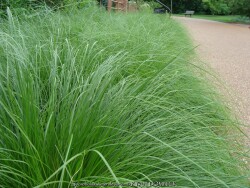

***Description for this grass available with future update!***Prairie Dropseed, is also known as Sporobolis heterolepis
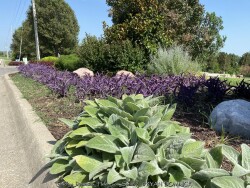

***Description for this perennial available with future update!***Helen Von Stein Lambs Ear, is also known as Stachys byzantina 'Helen Von Stein'